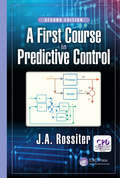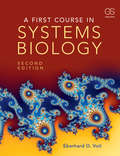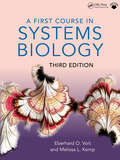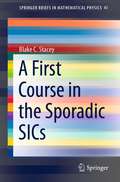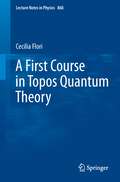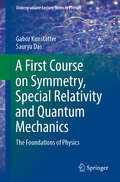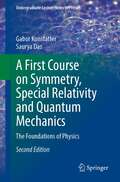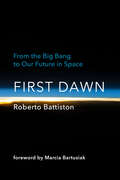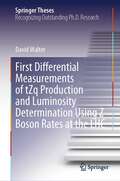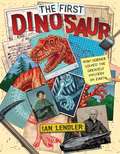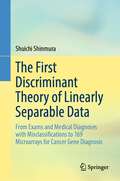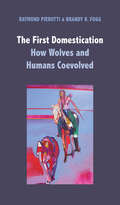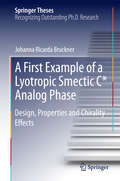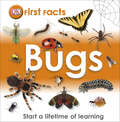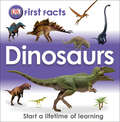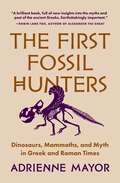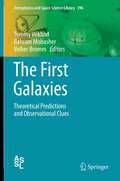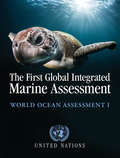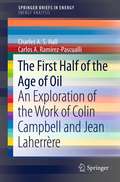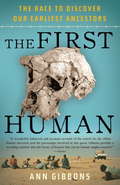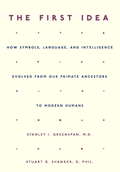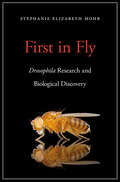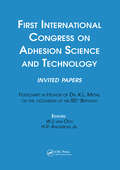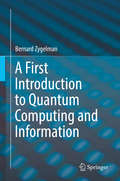- Table View
- List View
A First Course in Predictive Control, Second Edition (Control Series)
by J. A. RossiterThe book presents a significant expansion in depth and breadth of the previous edition. It includes substantially more numerical illustrations and copious supporting MATLAB code that the reader can use to replicate illustrations or build his or her own. The code is deliberately written to be as simple as possible and easy to edit. The book is an excellent starting point for any researcher to gain a solid grounding in MPC concepts and algorithms before moving into application or more advanced research topics. Sample problems for readers are embedded throughout the chapters, and in-text questions are designed for readers to demonstrate an understanding of concepts through numerical simulation.
A First Course in String Theory
by Barton ZwiebachAn accessible introduction to string theory, this book provides a detailed and self-contained demonstration of the main concepts involved. The first part deals with basic ideas, reviewing special relativity and electromagnetism while introducing the concept of extra dimensions. D-branes and the classical dynamics of relativistic strings are discussed next, and the quantization of open and closed bosonic strings in the light-cone gauge, along with a brief introduction to superstrings. The second part begins with a detailed study of D-branes followed by string thermodynamics. It discusses possible physical applications, and covers T-duality of open and closed strings, electromagnetic fields on D-branes, Born/Infeld electrodynamics, covariant string quantization and string interactions. Primarily aimed as a textbook for advanced undergraduate and beginning graduate courses, it will also be ideal for a wide range of scientists and mathematicians who are curious about string theory.
A First Course in Systems Biology
by Eberhard VoitA First Course in Systems Biology is an introduction for advanced undergraduate and graduate students to the growing field of systems biology. Its main focus is the development of computational models and their applications to diverse biological systems. The book begins with the fundamentals of modeling, then reviews features of the molecular inventories that bring biological systems to life and discusses case studies that represent some of the frontiers in systems biology and synthetic biology. In this way, it provides the reader with a comprehensive background and access to methods for executing standard systems biology tasks, understanding the modern literature, and launching into specialized courses or projects that address biological questions using theoretical and computational means. New topics in this edition include: default modules for model design, limit cycles and chaos, parameter estimation in Excel, model representations of gene regulation through transcription factors, derivation of the Michaelis-Menten rate law from the original conceptual model, different types of inhibition, hysteresis, a model of differentiation, system adaptation to persistent signals, nonlinear nullclines, PBPK models, and elementary modes. The format is a combination of instructional text and references to primary literature, complemented by sets of small-scale exercises that enable hands-on experience, and large-scale, often open-ended questions for further reflection.
A First Course in Systems Biology
by Eberhard Voit Melissa L. KempA First Course in Systems Biology, Third Edition is an introduction to the growing field of systems biology for advanced undergraduates and graduate students. Its focus is the design and analysis of computational models and their applications to diverse biomedical phenomena, from simple networks and kinetics to complex pathway systems, signal transduction, personalized medicine, and interacting populations. The book begins with the fundamentals of computational modeling, then reviews features of the molecular inventories that bring biological systems to life and ends with case studies that reflect some of the frontiers in systems biology. In this way, the First Course provides the reader with a comprehensive background and with access to methods for executing standard tasks of biomedical systems analysis, exposure to the modern literature, and a foundation for launching into specialized projects that address biomedical questions with theoretical and computational means.This third edition has been thoroughly updated. It provides an introduction to agent-based and multiscale modeling, a deeper account of biological design principles, and the optimization of metabolic flux distributions. This edition also discusses novel topics of synthetic biology, personalized medicine, and virtual clinical trials that are just emerging on the horizon of this field.
A First Course in the Sporadic SICs (SpringerBriefs in Mathematical Physics #41)
by Blake C. StaceyThis book focuses on the Symmetric Informationally Complete quantum measurements (SICs) in dimensions 2 and 3, along with one set of SICs in dimension 8. These objects stand out in ways that have earned them the moniker of "sporadic SICs". By some standards, they are more approachable than the other known SICs, while by others they are simply atypical. The author forays into quantum information theory using them as examples, and the author explores their connections with other exceptional objects like the Leech lattice and integral octonions. The sporadic SICs take readers from the classification of finite simple groups to Bell's theorem and the discovery that "hidden variables" cannot explain away quantum uncertainty.While no one department teaches every subject to which the sporadic SICs pertain, the topic is approachable without too much background knowledge. The book includes exercises suitable for an elective at the graduate or advanced undergraduate level.
A First Course in Topos Quantum Theory (Lecture Notes in Physics #868)
by Cecilia FloriIn the last five decades various attempts to formulate theories of quantum gravity have been made, but none has fully succeeded in becoming the quantum theory of gravity. One possible explanation for this failure might be the unresolved fundamental issues in quantum theory as it stands now. Indeed, most approaches to quantum gravity adopt standard quantum theory as their starting point, with the hope that the theory's unresolved issues will get solved along the way. However, these fundamental issues may need to be solved before attempting to define a quantum theory of gravity. The present text adopts this point of view, addressing the following basic questions: What are the main conceptual issues in quantum theory? How can these issues be solved within a new theoretical framework of quantum theory? A possible way to overcome critical issues in present-day quantum physics - such as a priori assumptions about space and time that are not compatible with a theory of quantum gravity, and the impossibility of talking about systems without reference to an external observer - is through a reformulation of quantum theory in terms of a different mathematical framework called topos theory. This course-tested primer sets out to explain to graduate students and newcomers to the field alike, the reasons for choosing topos theory to resolve the above-mentioned issues and how it brings quantum physics back to looking more like a "neo-realist" classical physics theory again.
A First Course on Symmetry, Special Relativity and Quantum Mechanics: The Foundations of Physics (Undergraduate Lecture Notes in Physics)
by Gabor Kunstatter Saurya DasThis book provides an in-depth and accessible description of special relativity and quantum mechanics which together form the foundation of 21st century physics. A novel aspect is that symmetry is given its rightful prominence as an integral part of this foundation. The book offers not only a conceptual understanding of symmetry, but also the mathematical tools necessary for quantitative analysis. As such, it provides a valuable precursor to more focused, advanced books on special relativity or quantum mechanics.Students are introduced to several topics not typically covered until much later in their education.These include space-time diagrams, the action principle, a proof of Noether's theorem, Lorentz vectors and tensors, symmetry breaking and general relativity. The book also provides extensive descriptions on topics of current general interest such as gravitational waves, cosmology, Bell's theorem, entanglement and quantum computing.Throughout the text, every opportunity is taken to emphasize the intimate connection between physics, symmetry and mathematics.The style remains light despite the rigorous and intensive content. The book is intended as a stand-alone or supplementary physics text for a one or two semester course for students who have completed an introductory calculus course and a first-year physics course that includes Newtonian mechanics and some electrostatics. Basic knowledge of linear algebra is useful but not essential, as all requisite mathematical background is provided either in the body of the text or in the Appendices. Interspersed through the text are well over a hundred worked examples and unsolved exercises for the student.
A First Course on Symmetry, Special Relativity and Quantum Mechanics: The Foundations of Physics (Undergraduate Lecture Notes in Physics)
by Gabor Kunstatter Saurya DasThis book provides an in-depth and accessible description of special relativity and quantum mechanics which together form the foundation of 21st century physics. A novel aspect is that symmetry is given its rightful prominence as an integral part of this foundation. The book offers not only a conceptual understanding of symmetry, but also the mathematical tools necessary for quantitative analysis. As such, it provides a valuable precursor to more focused, advanced books on special relativity or quantum mechanics.Students are introduced to several topics not typically covered until much later in their education.These include space-time diagrams, the action principle, a proof of Noether's theorem, Lorentz vectors and tensors, symmetry breaking and general relativity. The book also provides extensive descriptions on topics of current general interest such as gravitational waves, cosmology, Bell's theorem, entanglement and quantum computing.Throughout the text, every opportunity is taken to emphasize the intimate connection between physics, symmetry and mathematics.The style remains light despite the rigorous and intensive content. The book is intended as a stand-alone or supplementary physics text for a one or two semester course for students who have completed an introductory calculus course and a first-year physics course that includes Newtonian mechanics and some electrostatics. Basic knowledge of linear algebra is useful but not essential, as all requisite mathematical background is provided either in the body of the text or in the Appendices. Interspersed through the text are well over a hundred worked examples and unsolved exercises for the student.
First Dawn: From the Big Bang to Our Future in Space
by Roberto BattistonFrom the very first moments of the universe to the birth of the first star, our solar system, and our planet: a physicist traces the known and the unknown.Since the beginning of the twentieth century, the horizon of our knowledge about the universe has expanded to encompass the infinitesimally small—and the infinitely vast. In First Dawn, physicist Roberto Battiston takes readers on a journey through space and time, to the boundaries of our knowledge and beyond. From the violence of the Big Bang and the birth of the first star, hundreds of millions of years later, to the emergence of our solar system, the dawn of life on Earth, and the possibility of life on other planets, Battiston maps what we know about the universe and how we came to know it—cautioning us, however, that what we know is a minuscule fraction of what there is to know. Battiston outlines discoveries by some of the greatest theoretical physicists of the twentieth century, including Einstein, Bohr, Schrödinger, Heisenberg, Fermi, and Hubble; discusses the mysteries of dark energy and dark matter; and considers what it means for the universe to have emerged out of nothing. The ignition of the first star illuminated a universe that had been expanding, unobserved and unobservable, in the dark. Drawing on his own research, Battiston discusses the birth of the Sun, the formation of planets, the origins of life, interstellar migrations, extrasolar planets, black holes, gravitational waves, and much more. But, he warns, for some questions—the dimensions of the universe, for example, or the existence of other universes—we are destined to remain in the realm of speculation.
First Differential Measurements of tZq Production and Luminosity Determination Using Z Boson Rates at the LHC (Springer Theses)
by David WalterThis thesis describes two groundbreaking measurements in the precision frontier at the LHC: the first ever differential measurement of the Z-associated single top quark (tZq) production, and the luminosity measurement using Z boson production rate for the first time in CMS. Observed only in 2018, the tZq process is of great importance in probing top quark electroweak couplings. These couplings are natural places for new phenomena to happen in the top quark sector of the standard model. Yet, they are the least explored directly. One has to obtain a firm understanding of the modeling of sensitive distributions to new top-Z interactions. The present analysis marks a major milestone in this long-term effort. All distributions relevant for new phenomena, and/or modeling of tZq, are studied in full depth using advanced Machine Learning techniques.The luminosity and its uncertainty contributes to every physics result of the experiment. The method minutely developed in this thesis provides a complementary measurement that results in a significant overall reduction of uncertainties.
The First Dinosaur: How Science Solved the Greatest Mystery on Earth
by Ian LendlerJoin early scientists as they piece together one of humanity’s greatest puzzles—the fossilized bones of the first dinosaur! <P><P>Dinosaurs existed. That’s a fact we accept today. But not so long ago, the concept that these giant creatures could have roamed Earth millions of years before humans was unfathomable. People thought what we know as dinosaur bones were the bones of giant humans. Of large elephants. Of angels, even. So, how did we get from angel wings to the T-Rex? <P><P> The First Dinosaur tells the story of the idea of dinosaurs, and the chain of fossil discoveries and advances in science that led to that idea. Be prepared to meet eccentric men and overlooked women who uncovered the pieces to a puzzle so much bigger than themselves, a puzzle far stranger and more spectacular than they could have ever imagined.
The First Discriminant Theory of Linearly Separable Data: From Exams and Medical Diagnoses with Misclassifications to 169 Microarrays for Cancer Gene Diagnosis
by Shuichi ShinmuraThis book deals with the first discriminant theory of linearly separable data (LSD), Theory3, based on the four ordinary LSD of Theory1 and 169 microarrays (LSD) of Theory2. Furthermore, you can quickly analyze the medical data with the misclassified patients which is the true purpose of diagnoses. Author developed RIP (Optimal-linear discriminant function finding the combinatorial optimal solution) as Theory1 in decades ago, that found the minimum misclassifications. RIP discriminated 63 (=26−1) models of Swiss banknote (200*6) and found the minimum LSD: basic gene set (BGS). In Theory2, RIP discriminated Shipp microarray (77*7129) which was LSD and had only 32 nonzero coefficients (first Small Matryoshka; SM1). Because RIP discriminated another 7,097 genes and found SM2, the author developed the Matryoshka feature selection Method 2 (Program 3), that splits microarray into many SMs. Program4 can split microarray into many BGSs. Then, the wide columnLSD (Revolution-0), such as microarray (n Theory3 shows the surprising results of six ordinary data re-analyzed by Theory1 and Theory2 knowledge. Essence of Theory3 is described by using cephalopelvic disproportion (CPD) data. RIP discriminates CPD data (240*19) and finds two misclassifications unique for cesarean and natural-born groups. CPD238 omitting two patients becomes LSD, which is the first case selection method. Program4 finds BGS (14 vars.) the only variable selection method for Theory3. 32 (=25) models, including BGS, become LSD among (219−1) models. Because Program2 confirms BGS has the minimum average error rate, BGS is the most compact and best model satisfying Occam’s Razor. With this book, physicians obtain complete diagnostic results for disease, and engineers can become a true data scientist, by obtaining integral knowledge ofstatistics and mathematical programming with simple programs.
The First Domestication: How Wolves and Humans Coevolved
by Raymond Pierotti Brandy R. FoggA riveting look at how dog and humans became best friends, and the first history of dog domestication to include insights from indigenous peoples In this fascinating book, Raymond Pierotti and Brandy Fogg change the narrative about how wolves became dogs and in turn, humanity’s best friend. Rather than describe how people mastered and tamed an aggressive, dangerous species, the authors describe coevolution and mutualism. Wolves, particularly ones shunned by their packs, most likely initiated the relationship with Paleolithic humans, forming bonds built on mutually recognized skills and emotional capacity. This interdisciplinary study draws on sources from evolutionary biology as well as tribal and indigenous histories to produce an intelligent, insightful, and often unexpected story of cooperative hunting, wolves protecting camps, and wolf-human companionship. This fascinating assessment is a must-read for anyone interested in human evolution, ecology, animal behavior, anthropology, and the history of canine domestication.
A First Example of a Lyotropic Smectic C* Analog Phase: Design, Properties and Chirality Effects (Springer Theses)
by Johanna Ricarda BrucknerIn this thesis Johanna Bruckner reports the discovery of the lyotropic counterpart of the thermotropic SmC* phase, which has become famous as the only spontaneously polarized, ferroelectric fluid in nature. By means of polarizing optical microscopy, X-ray diffraction and electro-optic experiments she firmly establishes aspects of the structure of the novel lyotropic liquid crystalline phase and elucidates its fascinating properties, among them a pronounced polar electro-optic effect, analogous to the ferroelectric switching of its thermotropic counterpart. The helical ground state of the mesophase raises the fundamental question of how chiral interactions are "communicated" across layers of more or less disordered and achiral solvent molecules which are located between adjacent bi-layers of the chiral amphiphile molecules. This thesis bridges an important gap between thermotropic and lyotropic liquid crystals and pioneers a new field of liquid crystal research.
First Facts: Start a Lifetime of Learning (First Facts)
by DKWith uncomplicated designs, eye catching images and simple text filled with interesting facts, DK's new First Facts series will excite and delight young children while answering the age old questions "who?" "what?" "when?" "where?" and "why?" Little ones will love learning all about bugs and their world in this exciting new book!
First Facts: Start a Lifetime of Learning (First Facts)
by DKGet all the facts! First Facts is a early learning series that explains to young readers everything they want to know about exciting topics like the natural world, history, science, and machines. Fitting perfectly between preschool and elementary school levels, this series boasts visually exciting spreads that encourage children to flip through regardless of whether they can read yet. The text offers a basic foundation on the subject and is full of fascinating facts and figures — perfect for reading aloud, or for kids to decipher on their own when they're learning to read.
The First Fossil Hunters: Dinosaurs, Mammoths, and Myth in Greek and Roman Times
by Adrienne MayorThe fascinating story of how the fossils of dinosaurs, mammoths, and other extinct animals influenced some of the most spectacular creatures of classical mythologyGriffins, Centaurs, Cyclopes, and Giants—these fabulous creatures of classical mythology continue to live in the modern imagination through the vivid accounts that have come down to us from the ancient Greeks and Romans. But what if these beings were more than merely fictions? What if monstrous creatures once roamed the earth in the very places where their legends first arose? This is the arresting and original thesis that Adrienne Mayor explores in The First Fossil Hunters. Through careful research and meticulous documentation, she convincingly shows that many of the giants and monsters of myth did have a basis in fact—in the enormous bones of long-extinct species that were once abundant in the lands of the Greeks and Romans.As Mayor shows, the Greeks and Romans were well aware that a different breed of creatures once inhabited their lands. They frequently encountered the fossilized bones of these primeval beings, and they developed sophisticated concepts to explain the fossil evidence, concepts that were expressed in mythological stories. The legend of the gold-guarding griffin, for example, sprang from tales first told by Scythian gold-miners, who, passing through the Gobi Desert at the foot of the Altai Mountains, encountered the skeletons of Protoceratops and other dinosaurs that littered the ground.Like their modern counterparts, the ancient fossil hunters collected and measured impressive petrified remains and displayed them in temples and museums; they attempted to reconstruct the appearance of these prehistoric creatures and to explain their extinction. Long thought to be fantasy, the remarkably detailed and perceptive Greek and Roman accounts of giant bone finds were actually based on solid paleontological facts. By reading these neglected narratives for the first time in the light of modern scientific discoveries, Adrienne Mayor illuminates a lost world of ancient paleontology.
The First Galaxies
by Tommy Wiklind Volker Bromm Bahram MobasherNew observations of the period between the cosmic recombination and the end of reionization are posing intriguing questions about where the first generations of stars were formed, how the first galaxies were assembled, whether these galaxies have low redshift counterparts, and what role the early galaxies played in the reionization process. Combining the new observational data with theoretical models can shed new light on open issues regarding the star formation process, its role in the reionization of the Universe, and the metal enrichment in galaxies at those early epochs. This volume brings together leading experts in the field to discuss our current level of understanding and what may come in the near future as our observational as well as theoretical tools improve. The book confronts the theory of how the first stars, black holes, and galaxies formed with current and planned observations. This synthesis is very timely, just ahead of the establishment of major new facilities, such as the James Webb Space Telescope (JWST), a next-generation, millimeter/sub-millimeter observatory in the Atacama desert (ALMA), and ground-based Extremely Large Telescopes (ELT). Together, they will revolutionize the study of the most distant objects in the Universe. This volume is aimed at beginning graduate students but can also serve as a reference work for active researchers in the field. Apart from presenting the fundamental concepts involved, it also provides an introduction to the methods and techniques used. The book will also be useful to anyone with an astrophysical background who needs an effective starting point for learning about the first stars and galaxies.
The First Global Integrated Marine Assessment: World Ocean Assessment I
by United NationsThe World Ocean Assessment - or, to give its full title, The First Global Integrated Marine Assessment - is the outcome of the first cycle of the United Nations' Regular Process for Global Reporting and Assessment of the State of the Marine Environment, including Socioeconomic Aspects. The Assessment provides vital, scientifically-grounded bases for the consideration of ocean issues, including climate change, by governments, intergovernmental agencies, non-governmental agencies and all other stakeholders and policymakers involved in ocean affairs. Together with future assessments and related initiatives, it will support the implementation of the recently adopted 2030 Agenda for Sustainable Development, particularly its ocean-related goals. Moreover, it will also form an important reference text for marine science courses. A prestigious and comprehensive report from the United Nations, with contributions from hundreds of the world's experts on the oceans. Provides the first integrated assessment of the state of the world's ocean, enabling policy makers and all stakeholders to consider for the first time the global and integrated effect on the ocean of decisions that they make. Identifies gaps in knowledge of the ocean and related human activities, helping policymakers and all stakeholders to identify and prioritize areas for action, and input to the Sustainable Development Goals.
The First Half of the Age of Oil
by Charles A. Hall Carlos A. Ramírez-PascualliAccording to the conventional wisdom, we live in a post-industrial information age. This book, however, paints a different picture: We live in the age of oil. Petroleum fuels and feedstocks are responsible for much of what we take for granted in modern society, from chemical products such as fertilizer and plastics, to the energy that moves people and goods in a global economy. Oil is a nearly perfect fuel: Energy dense, safe to store, easy to transport, and mostly environmentally benign. Most importantly, oil has been cheap and abundant during the past 150 years. In 1998, two respected geologists, Colin Campbell and Jean Laherrère, published a detailed article announcing that the "end of cheap oil" would happen before 2010, which meant that the world would face a peak, or at least a plateau, in global daily oil production in the first decade of the new millennium. Today, two billion people under the age of 14 have lived the majority of their lives past the point when this century-long growth in oil supplies came to an end, which also marks the end of the first half of the age of oil. This transition has ushered in a new reality of high oil prices, stagnating oil supplies, and sluggish economies. In this book, a leading authority on energy explores the contributions and continuing legacy of Colin Campbell and Jean Laherrère, the two geologists who modified the terms of the debate about oil. The book provides a unique perspective and state-of-the-art overview of today's energy reality and its enormous economic and social implications. - Covers a topic that eclipses climate change as the most important but least understood challenge for contemporary society - Explores the works of Colin Campbell and Jean Laherrère, the leading authorities in the field of Peak Oil, authors of "The End of Cheap Oil" (Scientific American, 1998), and founding members of the Association for the Study of Peak Oil & Gas - Addresses a broad audience of scientists, engineers, and economists in a format that is accessible to the general public - Provides a complete overview of the basic geological, chemical, physical, economic and historical concepts that every oil consumer should understand - Presents the latest information on oil production, reserves, discoveries, prices, and fields in easy-to-understand graphs and plots
The First Human: The Race to Discover Our Earliest Ancestors
by Ann GibbonsThis dynamic chronicle of the race to find the "missing links" between humans and apes transports readers into the highly competitive world of fossil hunting and into the lives of the ambitious scientists intent on pinpointing the dawn of humankind. The quest to find where and when the earliest human ancestors first appeared is one of the most exciting and challenging of all scientific pursuits. The First Human is the story of four international teams obsessed with solving the mystery of human evolution and of the intense rivalries that propel them. An award-winning science writer, Ann Gibbons introduces the various maverick fossil hunters and describes their most significant discoveries in Africa. There is Tim White, the irreverent and brilliant Californian whose team discovered the partial skeleton of a primate that lived more than 4.4 million years ago in Ethiopia. If White can prove that it was hominid--an ancestor of humans and not of chimpanzees or other great apes--he can lay claim to discovering the oldest known member of the human family. As White painstakingly prepares the bones, the French paleontologist Michel Brunet comes forth with another, even more startling find. Well known for his work in the most remote and hostile locations, Brunet and his team uncover a stunning skull in Chad that could set the date of the beginnings of humankind to almost seven million years ago. Two other groups--one led by the zoologist Meave Leakey, the other by the British geologist Martin Pickford and his partner, Brigitte Senut, a French paleontologist--enter the race with landmark discoveries of other fossils vying for the status of the first human ancestor. Through scrupulous research and vivid first-person reporting,The First Human takes readers behind the scenes to reveal the intense challenges of fossil hunting on a grand competitive scale.
The First Idea: How Symbols, Language, and Intelligence Evolved from our Primate Ancestors to Modern Humans
by Stanley I. Greenspan Stuart G. ShankerIn the childhood of every human being and at the dawn of human history there is an amazing and, until now, unexplained leap from simple genetically programmed behavior to language, symbolic thinking, and culture. In The First Idea, Stanley Greenspan and Stuart Shanker explore this missing link and offer brilliant new insights into two longstanding questions: how human beings first create symbols and how these abilities evolved and were transmitted across generations over millions of years. From fascinating research into the intelligence of both human infants and apes, they identify certain cultural practices that are vitally important if we are to have stable and reflective future societies.
First in Fly: <i>Drosophila</i> Research and Biological Discovery
by Stephanie Elizabeth MohrA single species of fly, Drosophila melanogaster, has been the subject of scientific research for more than one hundred years. Why does this tiny insect merit such intense scrutiny? Drosophila’s importance as a research organism began with its short life cycle, ability to reproduce in large numbers, and easy-to-see mutant phenotypes. Over time, laboratory investigation revealed surprising similarities between flies and other animals at the level of genes, gene networks, cell interactions, physiology, immunity, and behavior. Like humans, flies learn and remember, fight microbial infection, and slow down as they age. Scientists use Drosophila to investigate complex biological activities in a simple but intact living system. Fly research provides answers to some of the most challenging questions in biology and biomedicine, including how cells transmit signals and form ordered structures, how we can interpret the wealth of human genome data now available, and how we can develop effective treatments for cancer, diabetes, and neurodegenerative diseases. Written by a leader in the Drosophila research community, First in Fly celebrates key insights uncovered by investigators using this model organism. Stephanie Elizabeth Mohr draws on these “first in fly” findings to introduce fundamental biological concepts gained over the last century and explore how research in the common fruit fly has expanded our understanding of human health and disease.
First International Congress on Adhesion Science and Technology---invited papers: Festschrift in Honor of Dr. K.L. Mittal on the Occasion of his 50th Birthday
by W.J. Van Ooij H. R. AndersonThis Festschrift documents the Proceedings of the First International Congress on Adhesion Science and Technology, held in honor of Dr. Kash Mittal on the occasion of his 50 birthday, in Amsterdam, The Netherlands, October 16-20, 1995. It contains the full accounts of the plenary and invited lectures, which are divided into the following seven part
A First Introduction to Quantum Computing and Information
by Bernard ZygelmanThis book addresses and introduces new developments in the field of Quantum Information and Computing (QIC) for a primary audience of undergraduate students. Developments over the past few decades have spurred the need for QIC courseware at major research institutions. This book broadens the exposure of QIC science to the undergraduate market. The subject matter is introduced in such a way so that it is accessible to students with only a first-year calculus background. Greater accessibility allows a broader range of academic offerings. Courses, based on this book, could be offered in the Physics, Engineering, Math and Computer Science departments. This textbook incorporates Mathematica-based examples into the book. In this way students are allowed a hands-on experience in which difficult abstract concepts are actualized by simulations. The students can ‘turn knobs" in parameter space and explore how the system under study responds. The incorporation of symbolic manipulation software into course-ware allows a more holistic approach to the teaching of difficult concepts. Mathematica software is used here because it is easy to use and allows a fast learning curve for students who have limited experience with scientific programming.
